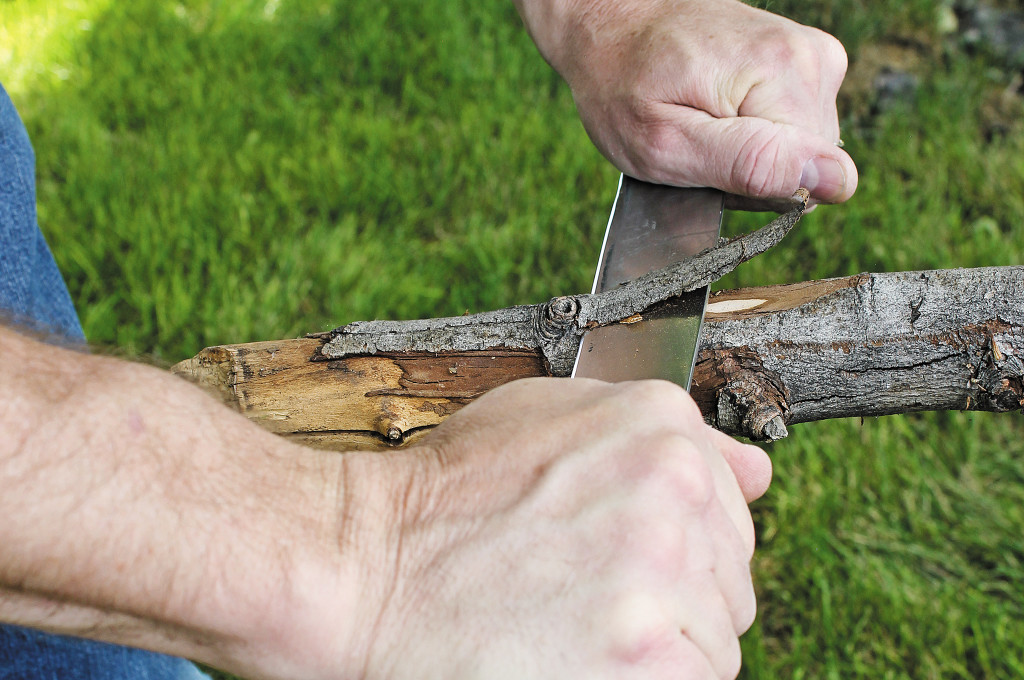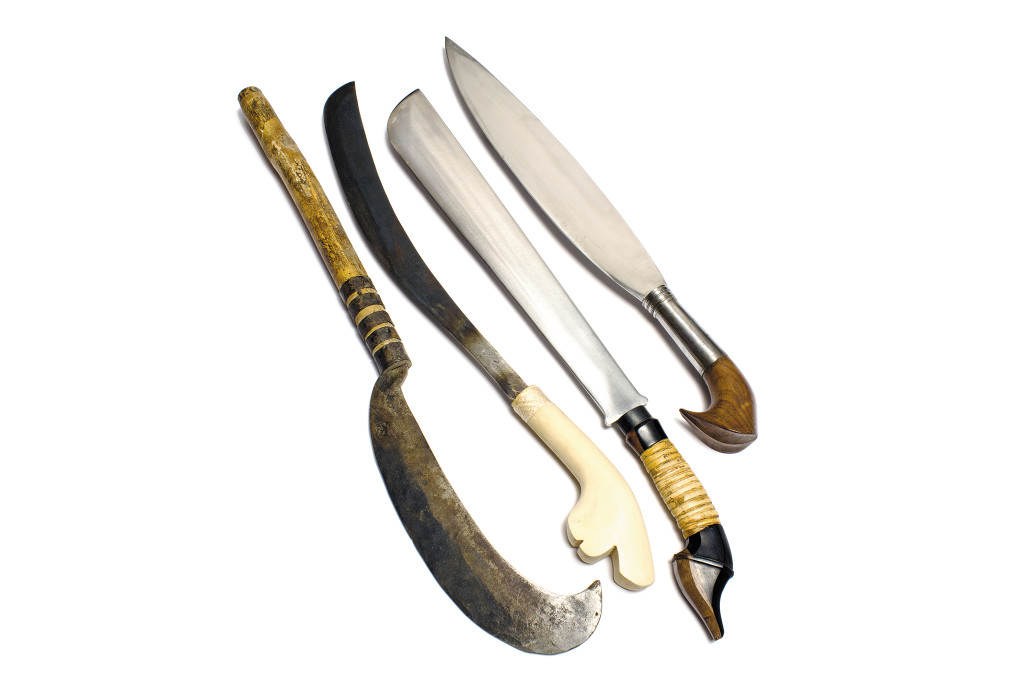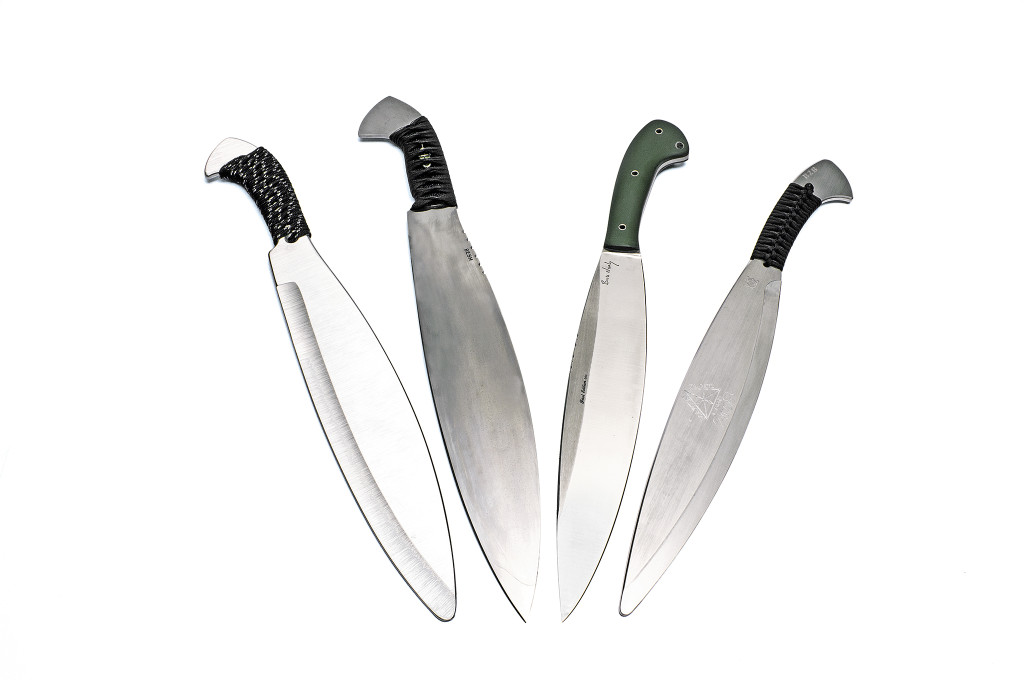RECOIL OFFGRID Gear Machetes: The Original Survival Multitools
Warning!
Using a machete is inherently dangerous. Don't attempt to recreate the images and techniques depicted here. For more, seek consultation or instruction from a reputable survival instructor or martial artist.
Media depictions of hardcore survival scenarios like to feature big knives — especially machetes and their brethren. From the zombie chopping of The Walking Dead to Denzel's well-choreographed limb-lopping in The Book of Eli, it seems that no good apocalypse is complete without a serious big blade.
All fiction aside, that's actually a pretty accurate statement. A good machete is an amazingly versatile implement that can effectively substitute for many other more mission-specific tools. When wielded with moderate skill, it's also an effective surrogate sword and a potent close-combat weapon. Think about it, no matter what type of survival situation you might imagine, the basic context is that something bad has happened that disrupts the normal operation of modern society. That disruption forces us to make do with more primitive technology for a while. Well, if you look at third-world countries that make do with more primitive technology all the time, you'll find that most of them regard machetes as indispensable all-purpose tools and folks in those societies are pretty damned skilled with them. That should be a hint.

(For the record, when I refer to “machete,” I use that as a term of convenience to represent any large, utilitarian chopping blade from any culture. If you prefer a golok, barong, bolo, or something similar, the same basic principles apply — with the possible exception of a thrust-worthy point.)
With this in mind, the following is a look at this bladed tool and its many uses (improvised and conventional) and how best to apply them in a real-world or SHTF scenario.
My affinity for machetes began a few careers ago when I was working for the U.S. government trying to resolve the fates of American POW/MIAs in Vietnam and Laos. Much of our work involved humping through the bush looking for aircraft crash sites and alleged burial sites. I was issued a standard G.I. machete and quickly learned its value as a tool for clearing trails, cutting helicopter LZs (landing zones), and other forms of weed whacking.
Light enough to wield without fatigue, yet heavy enough that the mass of the blade did most of the work, it easily handled everything from light foliage to thick, over-your-head elephant grass.
In a survival situation, you probably won't need to fell a redwood, but lopping branches or even taking down small saplings might make sense. For this kind of chopping, a machete is ideal, especially if you learn to vary the impact point of the edge. Typically the “sweet spot” for maximum energy transfer in a chop is about one-third of the way down from the blade's tip. Although this spot maximizes the power of the chop, it can also cause the blade to bind in thick material. Moving the impact point closer to your hand reduces sticking and increases control.
A froe, also known as a shake axe, is an old-school woodwright's tool used for splitting wood. It's basically an L-shaped tool with a wooden handle and a straight steel blade mounted perpendicular to it. The outside edge of the blade was sharpened, so you can hold the handle vertically while you baton the blade into the wood. Once it's in, lever the handle down to cleanly split the wood.
The advantage of a froe over an axe is that it allows you to precisely place the blade's edge — something that's difficult to do with a ballistic chop. For detail work, this kind of control is ideal. To duplicate it with a machete, place the edge on the end grain of the wood to be split so the blade extends at least a few inches beyond it. Using a short branch as a baton, strike the spine of the blade near the tip to drive the blade into the wood. Once you've gone to the desired depth, twist the blade to split the wood. If necessary, you can fashion a notched stick or split handle to provide greater leverage when twisting the blade. (Editor's note: For more on wood batoning, see “Firewood Fundamentals” on page 40.)
On quality machetes, the blade is quite thick and its spine is flat. This makes the spine of the blade a great improvised hammer for driving stakes, cracking coconuts, and other focused striking. (Naturally, you'll want to be careful when you draw back the tool to deliver another strike, as the edge will be pointing toward you.)
Drawknife
Another old-school woodworking tool is a drawknife, which is traditionally a single-edged blade about a foot long with handles on both ends. Gripped by both ends, it is drawn toward the user to shave a piece of wood.
The machete's wide blade makes it easy to grip with one hand on the handle and one wrapped over the spine of the blade (carefully avoiding the edge). Gripped like this, drawing the tool toward you naturally allows it to function as a drawknife. This style of use is great for removing bark, sharpening stakes, and similar tasks.

If your big blade has a broad tip, you can use it as an improvised entrenching tool for limited digging and grubbing. Grip it with both hands by the handle and the back of the blade and keep your fingers away from the sharp edge.
Some machetes are available with sawteeth on the spine. While this makes them less comfortable to use as drawknives and entrenching tools, sawteeth can be useful for some specific tasks, like cutting notches for fireboards, traps, and bowstrings. Personally, I feel a blunt blade spine makes the tool more versatile, but the option is out there.

Traditional big blades come in many shapes and sizes. Some are specialized for certain tasks while others are more...
A machete or any similar large-bladed knife is, for all intents and purposes, a sword. Whether it's lopping limbs off a tree or a marauding gangbanger, when wielded with skill and force, it makes an extremely potent and versatile weapon. The Filipino martial arts have a saying: “Wood seeks bone; steel seeks flesh.” In other words, impact weapons (like sticks) work best for breaking bones, while edged weapons are most effective at cutting muscles and tendons and making big holes in soft tissue.
Because of its unique attributes, the machete actually fills both these roles very well. The edge can be used to hack and cleave, and the back of the blade provides focused-impact for breaking bones. Adding the flat of the blade to the mix provides controlled, but still very impressive, impact to the mix. If you've ever seen a cop's flat leather sap, imagine feeding it some Viagra and rendering it in hardened steel and you've got one hell of a persuasion tool.
The broad, flat surface of a machete blade also makes applying proper sword/big knife blocking and parrying techniques easier. Unlike the movies, where actors bang their swords together indiscriminately, real sword tactics are designed to preserve the cutting edge by focusing blocks and parries on the back and, preferably, the flat of the blade. This avoids damage to the edge, keeps the edge from binding in softer weapons (like sticks), and spreads the force of impact over a larger surface area.
A machete can be used as a short sword. You can block with the flat of the blade, then immediately control the attacking arm with your left hand as you chop the bad guy's arm. If necessary, finish with a mobility-killing cut to the quadriceps just above the knee or to the neck.
Based on the goal of blocking with the flat of the blade and the need to make your close-combat skills as foolproof as possible, my preferred method of using the machete combatively is a tactic from the Filipino martial arts called de cuerdas. Start by gripping the machete in a normal grip in your dominant hand (since most of the world is right handed, I'll describe it from that perspective). Put your right foot forward and hold the machete vertically in front of your body with the edge facing to the left and the plane of the blade parallel to your chest. Now place the palm of your left hand on the flat of the blade, being careful to avoid the edge.
In this guard position, you literally “hide” behind the flat of the blade, using it as a shield. If an attack comes in, pivot toward it and drive both arms out simultaneously to block the incoming weapon or, even better, crush the fingers of the hand swinging it. Since you're starting with the flat of the blade pre-positioned for a proper block, you don't have to worry about trashing the edge of your blade.
Once you've stopped the incoming strike, quickly grab or check the attacker's arm with your left hand as you chamber your right hand to chop. With the attacker's arm momentarily frozen in place, clear your left hand if necessary and deliver a short, focused, downward chop to his bicep or triceps. Done properly, this will sever the muscle and instantly disable the arm. On the biceps side, it could also sever the nerves that control the hand and the brachial artery, which carries 10 percent of the body's blood flow — more than the carotid artery of the neck. Done with extreme enthusiasm, you could quite literally disarm your attacker.
To finish the job, deliver a powerful forehand cut to the front of the thigh, just above the knee. This will sever the quadriceps muscle, responsible for extending the knee and allowing that leg to support weight. Destroying this function creates a “mobility kill,” dropping your attacker in place and allowing you to create distance and safety.
To put maximum power in your machete cuts, learn to use a reinforced grip. Rather than swinging the weapon only with the dominant hand, place the palm of your support hand on the thumb side of the wrist of your weapon-wielding hand. This reinforced grip transfers the power of the support arm into the swing, increasing your cutting force substantially. It also helps you manage the follow-through of the weapon to safely decelerate and chamber it for a follow-up.
Assuming this grip from the de cuerdas guard position is easily accomplished by simply sliding your support hand down the spine of the blade to the wrist. Once you're there, learn to harness the rotation of your hips and shoulders to generate powerful forehand, backhand, and downward cuts, while using the reinforced grip as a “brake” to safely manage your follow through. When you're comfortable working with the edge, experiment with changing the plane of the blade relative to the plane of motion of the weapon to slap with the flat. If a situation doesn't warrant lethal force, a flat-blade slap across the knuckles or shin could be the less-lethal game changer you need to manage it effectively.
Machete-style big blades are the original survival multitools with a long, bloody history of effectiveness in combat. Inexpensive, readily available, and amazingly versatile, no well-stocked SHTF tool kit is complete without one.
Two of my all-time favorite knives actually began life as aluminum trainers that I designed for practicing big-blade tactics. The first one was a custom barong trainer that I designed as one of the souvenir items for my 2005 Martial Blade Camp training event. Made by Edges 2, the trainers and the tactics I taught to go with them were very well received by my students at the camp. To thank me for that experience, one of my certified instructors, Michael Rigg, took up a collection from the students and approached Canadian custom knife-maker Brent Beshara to render the trainer design as a live blade. After Brent did a portion of the work, he realized that the heat treating was beyond the capabilities of his shop and enlisted the help of his mentor, Canadian mastersmith Wally Hayes. The resulting barong is an extraordinary, one-of-a-kind weapon and the only co-authored work made by Hayes and Beshara. Needless to say, it's one of my prized possessions.

The author's most prized big blades are two custom barongs he designed, shown here a longside their training...
In 2008, history repeated itself. Working with my good friend Steve Rollert (who is also an amazingly skilled martial artist and head bladesmith of Keen Edge Knives), I designed another barong trainer that was a variant of one of his outstanding stock designs. After the students at camp had a chance to experience big-blade training, my friend Marc Galli, now an associate instructor in my Martial Blade Concepts system, approached renowned custom knife-maker Bud Nealy to translate the trainer into live steel. To date, Nealy has made three of these barongs (one for me and two for Marc) and they are simply incredible.
http://www.beshknives.com
http://www.budnealyknifemaker.com
http://www.hayesknives.com
http://www.keenedgeknives.com
My first real machete was a classic U.S. Army-issue parkerized machete made by Ontario that was part of the field kit issued to me when I was a team leader for POW/MIA investigation teams in Vietnam and Laos. After using it in the field a few times, I learned to hate the clunky handle scales that were about as ergonomic as a 2-by-4. After I replaced them with some home-spun scales made from Hawaiian Koa wood, it worked a whole lot better.
After experimenting with a number of native Vietnamese and Lao machete patterns, I finally invested in a Blackjack Knives Panga — a lightweight, extremely fast machete that was more like a Filipino barong than a traditional swept-point African panga. Its injection-molded rubber scales were extremely comfortable and offered an outstanding grip. Although the light blade was not well suited for hard chopping, it performed well on foliage up to and including green bamboo. In addition to clearing more than its share of landing zones, the Blackjack Panga also had the unique quality of “singing” every time it cut. Compared to the thick, primitively heat-treated knives of the local folks, the Panga's spring temper created a high-pitched “ping” with every cut — something that scared the snot out of my indigenous counterparts. Since our mission was a direct reflection of Cold War politics at their best, that was just fine with me.
Although my old-school big blades are still alive and well, since Blackjack's Panga has been long discontinued, I've retired them both for sentimental reasons. Their extremely worthy replacement is the Outdoor Edge Brush Demon.
Designed by noted custom knife-maker Jerry Hossom, the Brush Demon faithfully incorporates all the high-speed design features and performance characteristics of his coveted handmade blades into a budget-priced factory chopper. Its wickedly shaped blade is ground from tough 65Mn carbon steel and cloaked in a tough black powdercoat finish. The thermoplastic rubber handle brackets the user's hand for an extremely positive grip and dampens impact shock for fatigue-free cutting. Unlike most machetes, which have terrible sheaths, the Brush Demon comes complete with a high-quality nylon scabbard that offers multiple carry options. At an MSRP of $70 and street prices even lower, the Brush Demon is an outstanding value and a key component of my current kit.
 STAY SAFE: Download a Free copy of the OFFGRID Outbreak Issue
STAY SAFE: Download a Free copy of the OFFGRID Outbreak Issue
No Comments